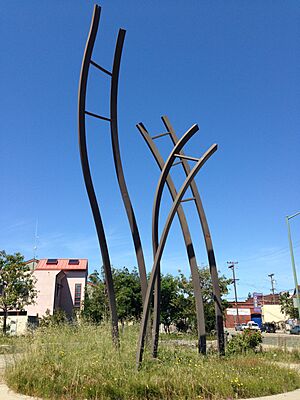Cypress Street Viaduct facts for kids
Quick facts for kids
Cypress Street Viaduct |
|
|---|---|
| Cypress Freeway, Nimitz Freeway | |
|
Route of the viaduct in relation to modern roads
|
|
| Route information | |
| Maintained by Caltrans | |
| Length | 1.78 mi (2.86 km) |
| Existed | June 11, 1957–October 17, 1989 |
| History | 1957–1984 as |
| Major junctions | |
| North end | |
| South end | Market Street at 7th Street in Oakland |
| Location | |
| Counties: | Alameda |
| Highway system | |
| Auxiliary route of the Interstate Highway System Main • Auxiliary • Business State highways in California(list • pre-1964) |
|
The Cypress Street Viaduct, also called the Cypress Structure or Cypress Freeway, was a special kind of raised highway in Oakland, California. It was about 1.6 miles (2.5 km) long and had two levels, with four lanes of traffic on each level.
This freeway was part of the Nimitz Freeway (State Route 17, and later Interstate 880). It was built along Cypress Street in the West Oakland area.
The viaduct opened on June 11, 1957. It was used until October 17, 1989. On that day, a strong earthquake hit the Bay Area. A large part of the viaduct's top deck fell onto the bottom deck. This terrible event caused 42 deaths and led to the freeway being torn down.
Today, the Cypress Freeway Memorial Park stands in Oakland. It is located at 14th Street and Mandela Parkway.
Contents
Building the Cypress Viaduct
The idea for this double-decked highway came about in 1949. The City of Oakland wanted to make it easier for cars to get to the San Francisco–Oakland Bay Bridge. Cypress Street was already a busy road, so building a freeway above it seemed like a good solution.
Construction happened in two main parts. The first part, which was an off-ramp structure, finished in October 1955. It cost about $1.7 million.
The main double-decked part of the viaduct began being built in February 1956. This larger section cost $8.3 million. In total, the entire viaduct project cost $10 million. When it officially opened on June 11, 1957, it was California's very first double-decked freeway.
The 1989 Loma Prieta Earthquake
On October 17, 1989, a powerful earthquake, known as the 1989 Loma Prieta earthquake, struck the Bay Area. The ground shook violently, and parts of the Cypress Street Viaduct collapsed.
Before the collapse, the top deck of the viaduct carried southbound traffic. The lower deck was for northbound traffic. Some parts of the viaduct were supported by two columns on each side. However, other sections had only a single supporting column underneath.
Engineers later found that the design of these single columns was not strong enough for a major earthquake. The way the columns were built, especially how the upper and lower parts were connected, made them weak. Also, the viaduct was built on land that was filled in over bay clay. This type of land can shake more during an earthquake. Some earthquake reinforcement was added in 1977, but it wasn't enough.
After the earthquake, local people rushed to help. They climbed onto the damaged structure to rescue those who were trapped. Many lives were saved. The collapse of the upper deck onto the lower deck caused 42 deaths. This was a very sad event. However, the number of deaths was lower than first feared. Many people had left work early to watch Game 3 of the 1989 World Series, which was between San Francisco and Oakland. So, there was less traffic on the freeway than usual.
After the viaduct was torn down, Cypress Street was renamed Mandela Parkway. This was done to honor Nelson Mandela. A beautiful landscaped area was planted where the viaduct once stood.
Rebuilding Oakland's Freeways
In 1997, the Nimitz Freeway was rebuilt. Instead of going over Cypress Street, the new freeway loops around the area. It is mostly at ground level, with some single-level raised sections. The new route took up space from a railroad yard, which had to be moved.
During the construction of the new freeway, archaeologists made interesting discoveries. They learned a lot about the people who lived in West Oakland in the 1800s.
Building the new freeway was very expensive. It cost about $1.2 billion, which was much more than first expected. This was because the new route required buying land from different companies and organizations, like the Southern Pacific Railroad and Amtrak. It also meant moving parts of the rail yard and replacing a parking lot with a parking garage. The new route even went through the Oakland Army Base. All these changes added to the cost.
Images for kids
-
Due to improper design of rebar placement, the support columns broke with ease, sending the structure down.
Photo by H.G. Wilshire, USGS -
Rep. Pete Stark, Mayor Lionel J. Wilson, President George H. W. Bush, and Rep. George Miller inspect Cypress Street Viaduct damage.












